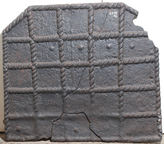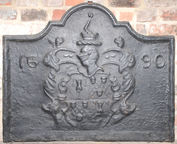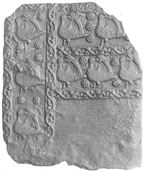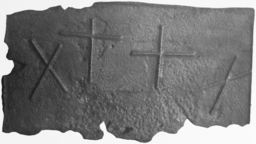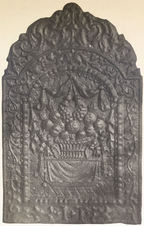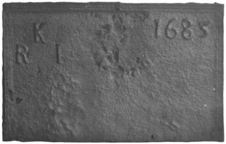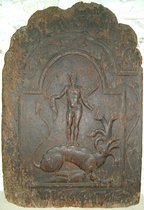-
461
Description: Canted rectangle; twisted rope edging; irregularly spaced, 5 x 5 rope grid; damage to top right corner.
Notes: A 5 x 3 variant is also known.
- Decoration tags:
- rectangular with canted top corners (shape)
- rope (edging)
- simple stamps
- objects
Manufactured: in the mid- to late-16th century in the Weald area of England.
Current location: Anne of Cleves House, Southover High Street, Lewes, East Sussex, England.
Museum number: 1944.24.046 (part of the Sussex Archaeological Society museum group)
- Attached to series:
- Rope design firebacks
-
462
Description: Rectangular with an arched rectangular style arch linked by symmetrical concave curves; ovolo moulding (top and sides); shield, helmet, crest and mantling of the family of Baker, of Mayfield, quartered with Farnden, of Sedlescombe: Quarterly, 1st and 4th, Argent, a tower between three keys erect sable (Baker); 2nd and 3rd, Purpure, a chevron vairy Or and gules, between three leopards’ faces Or (Farnden); crest (Baker): on a tower sable an arm embowed in mail holding in the hand a flint-stone proper. Date split by mantling.
Notes: A carved armorial on a plain, edged base board. John Baker (1644-1723) married Ruth, daughter and co-heiress of Peter Farnden, in 1663; she died in 1691. During their marriage the Farnden arms, would have been borne as an escutcheon of pretence in the centre of the arms of Baker, and not quartered with those of her husband until after her death. The date, 1690, is therefore spurious and would have been added to a later copy of a mid-18th century armorial fireback (see no. 16).
Inscription: 16 90
Arms: Baker of Mayfield quartering Farnden of Sedlescombe
- Decoration tags:
- rectangular with canted top corners and round arch (shape)
- ovolo (edging)
- carved pattern panels
- individual numbers
- armorial
- text
Manufactured: in the 19th century in the Weald area of England.
Current location: Barbican House, High Street, Lewes, East Sussex, England.
(part of the Sussex Archaeological Society museum group)
- Attached to series:
- Ironmasters armorial series
- Personal armorial firebacks
-
854
Description: Sub-rectangular fragment; undulating vine tendril strip repeated twice vertically from left edge with a bird stamp (probably a swan, a Lancastrian badge) repeated three times between, interspersed with a grape cluster stamp repeated seven times; vine tendril stamp repeated twice horizontally at right angles to rightmost vertical strip, three bird stamps between strips and two above, interspersed with seven grape cluster stamps.
Notes: This fragment incorporates common elements from a large series of firebacks.
- Decoration tags:
- rectangular (shape)
- trailing vine (edging)
- carved stamps
- animals
- plants
Manufactured: in the mid- to late-16th century possibly at Pounsley Furnace, Framfield in the Weald area of England.
Current location: Anne of Cleves House, Southover High Street, Lewes, East Sussex, England.
Museum number: LH000.924 (part of the Sussex Archaeological Society museum group)
- Attached to series:
- Pounsley series
- Vine strip series
- Swan series
- Furniture stamp firebacks
-
1048
Description: Canted rectangular shape; twisted rope edging (top and sides); two saltires formed of twisted rope irregularly arranged.
Notes: The small size suggests a 17th rather than a 16th century date. Formerly part of the J. H. Every collection.
- Decoration tags:
- rectangular with canted top corners (shape)
- rope (edging)
- simple stamps
- apotropaic
- objects
Manufactured: in the late-16th to early-17th century in the Weald area of England.
Current location: Anne of Cleves House, Southover High Street, Lewes, East Sussex, England.
Museum number: LH000.919 (part of the Sussex Archaeological Society museum group)
- Attached to series:
- Rope design firebacks
-
1046
Description: Sub-rectangular shape; twisted rope edging (top and sides); two crosses between two saltires, all formed of straight lengths of twisted rope and irregularly arranged.
Notes: A poorly cast, and probably early, fireback. Formerly part of the J. H. Every collection.
- Decoration tags:
- rectangular (shape)
- rope (edging)
- simple stamps
- apotropaic
- objects
Manufactured: in the early- to mid-16th century in the Weald area of England.
Current location: Anne of Cleves House, Southover High Street, Lewes, East Sussex, England.
Museum number: LH000.917 (part of the Sussex Archaeological Society museum group)
- Attached to series:
- Rope design firebacks
-
1047
Description: Sub-rectangular shape, no edging; three impressions formed of a dagger (c.350mm) with fleur-de-lys terminals: two, at each end, with the handle uppermost, the other inverted lower right of centre.
Notes: The dagger (length approx. 39cm) can be described as a 'cross-hilt' or 'quillon' type, possibly of German origin (ex. inf. Tobias Capwell). The grouping of three daggers may also have apotropaic significance in relation to the Trinity. Formerly part of the J. H. Every collection.
- Decoration tags:
- rectangular (shape)
- none (edging)
- simple stamps
- apotropaic
- objects
Manufactured: in the 16th century in the Weald area of England.
Current location: Anne of Cleves House, Southover High Street, Lewes, East Sussex, England.
Museum number: LH000.920 (part of the Sussex Archaeological Society museum group)
- Attached to series:
- Knife & Dagger stamp firebacks
-
1049
Description: Arched rectangular central panel with alternate two-bead and pellet edging; table with draped cloth surmounted by a basket containing fruit, swagged drapery above; arched rectangular border with fillet edging; descending vine with leaves and berries; bottom centre, initials separated by a lozenge; on top, symmetrical swirled foliage.
Notes: Typical pastiche of the 'Dutch' style of fireback produced with the option to affix it to a basket grate. The basket of fruit was probably inspired by still-life paintings by European artists of the first half of the 17th century. Formerly part of the J. H. Every collection.
Inscription: I T
Manufactured: in the early-18th century in England.
Current location: Anne of Cleves House, Southover High Street, Lewes, East Sussex, England.
Museum number: 1944.24.082 (part of the Sussex Archaeological Society museum group)
- Attached to series:
- British 'Dutch' style firebacks
- Fruit basket firebacks
-
1050
Description: Rectangular; triple-moulded edging (top and sides); top left, initials RKI in triad; top right, date.
Notes: The initials probably relate to a husband and wife, the top initial being that of their surname. Formerly part of the J. H. Every collection.
Inscription: RKI [triad] 1683
- Decoration tags:
- rectangular (shape)
- complex, furniture-derived (edging)
- carved stamps
- individual letters
- individual numbers
- text
Manufactured: in 1683 in the Weald area of England.
Current location: Anne of Cleves House, Southover High Street, Lewes, East Sussex, England.
Museum number: LH000.921 (part of the Sussex Archaeological Society museum group)
- Attached to series:
- 1660s-90s Wealden series
- Date & initials firebacks
-
927
Description: Carved wooden fireback pattern. Arched rectangular central panel, astragal and fillet edge, pictorial, Hercules, sword in hand, preparing to slay the Hydra; arched rectangular border, fillet edge, ivy leaves and tendrils, monogram at bottom; swirled foliage on top.
Notes: Unusually for a pattern, it was carved from a single piece of wood; formerly in the custody of William Hobday (d. 1883), last surviving ironworker at Ashburnham furnace, this pattern was given to the Sussex Archaeological Society by the Revd. J. Bickersteth.
Inscription: TAN
- Decoration tags:
- 'Dutch' (shape)
- fillet (edging)
- whole carved pattern
- pictorial
- mythological
- text
- animals
- humans
Manufactured: in the early-18th century in England.
Current location: Anne of Cleves House, Southover High Street, Lewes, East Sussex, England.
(part of the Sussex Archaeological Society museum group)
Citation: Dawson, C., 1903, 'Sussex Iron Work and Pottery', Sussex Archaeological Collections, 46, pp. 1-54.
- Attached to series:
- Patterns
- TAN series
-
928
Description: Carved wooden fireback pattern. Arched rectangular central panel with astragal and fillet edging; Phaëton riding Apollo’s chariot across the skies, the sun to the left behind clouds, a lion on ground below, between two trees; arched rectangular border with fillet edging; trailing convolvulus leaves surround the central panel.
Notes: The illustration upon which the design has been based has not been identified, save that it figures in book II of Ovid's Metamorphoses. The convolvulus border is a common feature of this series of firebacks; given to the Sussex Archaeological Society by the Rev. J. Bickersteth.
- Decoration tags:
- 'Dutch' (shape)
- fillet (edging)
- whole carved pattern
- planklines
- pictorial
- mythological
- animals
- humans
- objects
Manufactured: in the early-18th century in England.
Current location: Anne of Cleves House, Southover High Street, Lewes, East Sussex, England.
(part of the Sussex Archaeological Society museum group)
Citation: Baines, J. M., 1958, Wealden Firebacks (Hastings Museum).
Citation: Dawson, C., 1903, 'Sussex Iron Work and Pottery', Sussex Archaeological Collections, 46, pp. 1-54.
- Attached to series:
- Patterns
- TAN series
